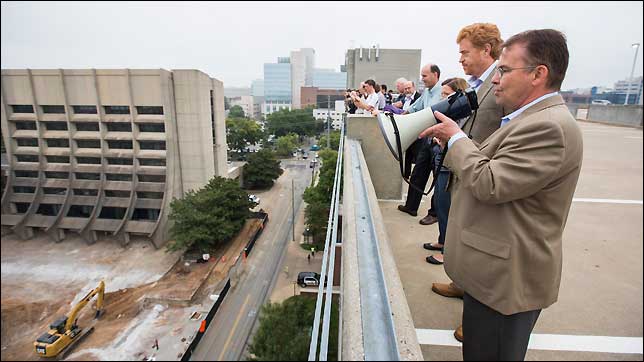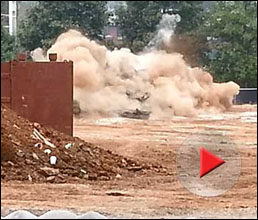
The university marked a milestone September 17 when blasting began at the construction site for its new seven-story 230,000-square-foot Engineering and Science Building.
Engineering Dean Philippe Fauchet was on hand to mark the occasion with bullhorn in hand, and he declared, “Let’s open the site.” After Fauchet’s 3-2-1 countdown, the blast foreman detonated the explosives, sending a pile of large black blasting mats about 8 feet in the air and dirt mushrooming outward.
“We’re here to celebrate the first step in the excavation,” said Fauchet, who stood on the top deck of the 25th Ave. garage with a number onlookers, many residents of Olin Hall, which will be connected to the new building through a two-story atrium.

Blasting and site excavation will continue until December, and the building itself will start to go up in the spring of 2015 at the site bordered by Highland, Garland and 25th avenues.
The majority of the complex is expected to be completed in the summer of 2016 at an estimated cost of $109 million. Construction within specialty tech spaces is expected to continue through much of 2017.
The building is designed to foster project teamwork and offer programs, instrumentation areas and core research space that will promote collaboration among Engineering and other disciplines across the university.
A key feature of the new building is an Innovation Center designed to connect students and faculty with technology transfer and industry mentors to accelerate the transfer of laboratory discoveries and student-developed concepts to the marketplace. Students participating in the center will experience the value of interdisciplinary teamwork and carry this model forward as they become leaders.

An Undergraduate Commons in the building will feature student-centered space designed to spark intellectual discussions and studies. Located next to the research laboratories and above the Innovation Center, the commons will help connect students with other researchers and innovators working in the building.
A cleanroom and advanced imaging facilities will provide capabilities that students and faculty need to advance discoveries in areas such as nanocomposites, smart materials, advanced energy storage and nano‐bio‐technology.
Five floors of the building can support a variety of research laboratories and new trans‐institutional programs designed to attract and retain top academic leadership in the School of Engineering and the College of Arts and Science.
Contact:
Brenda Ellis, (615) 343-6314
Brenda.Ellis@Vanderbilt.edu
Twitter @VUEngineering